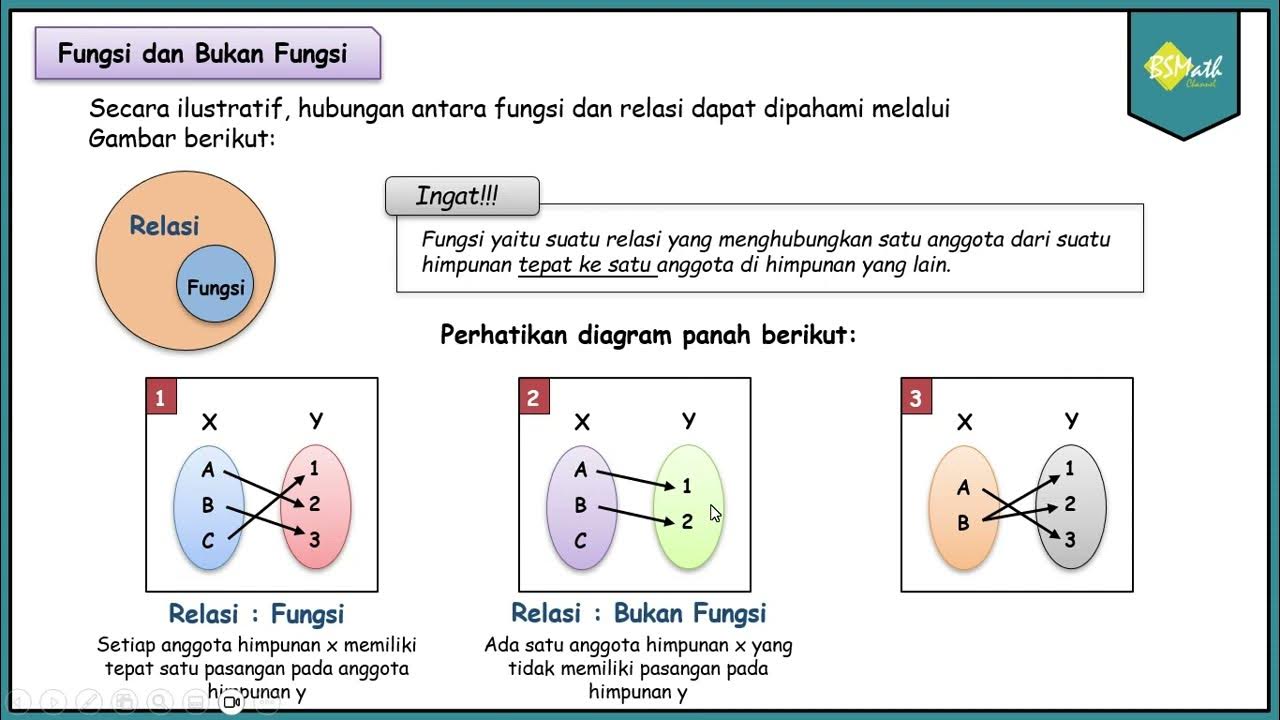Relations and Functions | General Mathematics | Grade 11
Summary
TLDRThis educational video delves into the concepts of relations and functions in mathematics. It explains that a relation is a set of ordered pairs with a domain and range, while a function is a special type of relation where each domain value is uniquely paired with a range value. The video uses examples to illustrate these concepts and introduces the vertical line test for identifying functions from graphs. It encourages viewers to engage with the content by asking questions in the comments section.
Takeaways
- 📚 The video discusses the concept of relations and functions, particularly focusing on the domain and range in the context of ordered pairs.
- 🔍 The domain of a relation is defined as the set of all x-components of the ordered pairs, while the range consists of all y-components.
- 🔑 A relation is a rule that correlates values from one set, known as the domain, to another set, known as the range.
- 🔢 The video provides examples to illustrate the domain and range, such as the relation {(1,3), (2,4), (5,7), (6,8)} with domain {1, 2, 5, 6} and range {3, 4, 7, 8}.
- 🎯 A function is a type of relation where each member of the domain is paired with exactly one member of the range, ensuring a unique output for each input.
- ✅ The video uses the vertical line test to determine if a graph represents a function, where a graph passes the test if any vertical line intersects it at only one point.
- 📉 The script includes a mapping diagram exercise to identify functions, where each x-component corresponds to a unique y-component.
- 📈 Examples of functions are given, such as {(1,2), (2,3), (3,4), (4,5)} where each input has a unique output.
- ❌ Non-function examples are also provided, such as a relation where the same x-value is paired with different y-values, violating the function rule.
- 📊 The video explains that not every relation is a function, and it is important to differentiate between the two based on the uniqueness of the y-values for each x-value.
- 👋 The video concludes with an invitation for viewers to subscribe, ask questions, and seek clarifications in the comments section.
Q & A
What is a relation in the context of the video?
-A relation is any set of ordered pairs, where the set of all x components of the ordered pairs is called the domain, and the set of all y components is called the range.
What is the domain of a relation?
-The domain of a relation is the set of all x components of the ordered pairs within the relation.
What is the range of a relation?
-The range of a relation is the set of all y components of the ordered pairs within the relation.
How is the domain related to an adding machine in the video's analogy?
-In the analogy, the domain is likened to the input of an adding machine, which is where you add values from a set of values.
What is a function in the context of mathematical relations?
-A function is a type of relation where each member of the domain is paired to exactly one member of the range, and no two ordered pairs have the same x value but different y values.
How can you determine if a relation is a function based on the script?
-You can determine if a relation is a function by checking if there is a unique output for each input, meaning no x value is repeated with different y values.
What is the significance of the vertical line test in the context of functions?
-The vertical line test is a method to determine if a graph represents a function. If any vertical line drawn through the graph touches it at exactly one point, then the graph represents a function.
How does the video explain the representation of functions through mapping diagrams?
-The video explains that functions can be represented through mapping diagrams where elements of the domain are mapped to the elements of the range using arrows, indicating a unique correspondence between inputs and outputs.
What is the difference between a relation and a function as explained in the video?
-A relation is a broader concept that can include multiple outputs for the same input, while a function is a specific type of relation where each input is associated with exactly one output.
Why is the graph of an ellipse not considered a function according to the video?
-The graph of an ellipse is not considered a function because it fails the vertical line test; a vertical line can intersect the ellipse at more than one point, indicating multiple outputs for the same input.
How can one represent a function graphically as shown in the video?
-A function can be represented graphically in the Cartesian plane, and its function nature can be verified using the vertical line test, where a vertical line should intersect the graph at no more than one point.
Outlines

This section is available to paid users only. Please upgrade to access this part.
Upgrade NowMindmap

This section is available to paid users only. Please upgrade to access this part.
Upgrade NowKeywords

This section is available to paid users only. Please upgrade to access this part.
Upgrade NowHighlights

This section is available to paid users only. Please upgrade to access this part.
Upgrade NowTranscripts

This section is available to paid users only. Please upgrade to access this part.
Upgrade NowBrowse More Related Video

Relations and Functions | Class 12 Maths | Complete NCERT Chapter 1 | Harsh Sir @VedantuMath

Matematika SMA - Relasi dan Fungsi (1) - Pengertian Relasi dan Fungsi, Domain Fungsi (A)

Materi Matematika Kelas 8: Relasi dan Fungsi

Relation and Functions || MATHEMATICS IN THE MODERN WORLD

CBSE Class 11 Maths Project-Relations & Functions

Pengertian Fungsi - Matematika Kelas XI Kurikulum Merdeka
5.0 / 5 (0 votes)